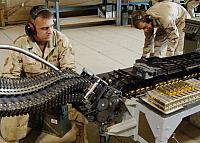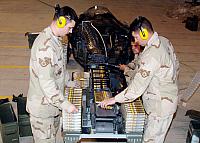Fighter Jet News
F-16 Fighting Falcon News
F-16s use new 20mm ammo in battle
March 2, 2007 (by
Capt. Ken Hall) -
Air Force F-16 pilots employed a new 20mm cannon round in their M61/A1 'Vulcan' Gatling guns for the first time, first validating the rounds at a firing range on Feb. 22, and then employing them in battle Feb. 26.

All niceties aside, it's just what fighter pilots do--break things and blow stuff up.
Here in Iraq, the 332nd Air Expeditionary Wing (AEW) fielded a way to do that safer, with greater effect, and less collateral damage.
Ground forces east of Baghdad chased insurgents into a building and then called in close air support. Fightin' Samurai F-16s from the wing's 14th Expeditionary Fighter Squadron (EFS) responded to the call, strafing the insurgent stronghold and vehicle, said squadron commander Lt. Col. Chuck Toplikar.
Improved PGU-28A/B 20mm ammunition began replacing the long-used M56 high explosive incendiary (HEI) ammunition in the wing's F-16s, making pilots' jobs easier, safer and more effective. That's a lofty claim, but 332 AEW pilots' recent combat sorties prove the ammo is enhancing combat airpower.
The older M56 ammo required a specific impact velocity in order for its HEI properties to function correctly. In other words, the round wouldn't explode on impact if it didn't get there fast enough, so pilots had to get in closer for the kill. Of course the impact and mass of the projectile would still damage the target, but wouldn't achieve the full explosive effect it was designed for.
The new cannon round employs a more aerodynamic design and "hotter load" which increases its velocity and effective range, allowing greater standoff distance for pilots. That further distance directly translates to greater pilot safety overall because they can fire the new rounds from more than a mile and a half away, said Capt. Jim Maxwell, Deputy Chief of Weapons and Tactics at the wing.
The captain also notes that when bullets can be used instead of bombs, the potential for collateral damage is reduced as well, increasing airpower options for the ground commander who must calculate the desired result when calling in air support, according to Captain Maxwell.
Acquiring and readying the new ammo for use, though, was not an easy task.
After airpower leaders determined the enhancements the new cannon round could bring, an "Urgent Operational Need" request was generated in order to procure the PGU-28A/B, according to Senior Master Sgt. Michael Ray, 332nd Expeditionary Maintenance Squadron (EMXS). New ammo came from as far away as Naval Air Stations Miramar, Calif., and Sigonella, Sicily, as well as Naval Base Guam and Marine Corps Air Station, Iwakuni, Japan.
When the ammo arrived, 332 EMXS munitions personnel received and inspected more than 80,000 rounds in a lightning-fast six hours--compared to the 8,000 usually processed in a typical day. "It ain't ammo 'til we say it's ammo," Sergeant Ray said.
The PGU-28A/B rounds then made their way through loading machines called "replenishers" to fill drummed universal ammunition loading systems, or UALS, before being handed off to weapons loaders from the 332nd Expeditionary Aircraft Maintenance Squadron (EAMXS) who arm the wing's F-16s.
"EAXMS Airmen toiled round the clock as well swapping PGU ammo for M56 rounds over a period of two days," said Capt. Kevin Tanner, officer in charge there. That hard work allowed F-16 pilots to employ the ammo quickly.
The ammo swap out had to be accomplished around the flying schedule and alert commitment so it wouldn't disrupt the Air Tasking Order--the 'script' for air operations in theater.
The weapons crew and ammo Airmen are a diverse group deploying from all over--Aviano AB, Italy and Misawa AB, Japan on the active-duty side; Selfridge Air National Guard Base, Mich., Syracuse ANGB, N.Y., and Duluth ANGB, Minn., and Joint Reserve Base Ellington Field in Houston, Texas.
"Our ammo and weapons loader personnel are just phenomenal!" said Lt. Col. Patrick Kumashiro, deputy commander of the 332nd Expeditionary Maintenance Group (EMXG). "Ours is a Total Force team effort, and they managed to get our F-16s loaded within an amazing 48 hours of the ammo's arrival."
Benefiting from all that hard work were the "Buzzard" F-16 pilots first to use the new cannon rounds. Capt. George Watkins and 1st Lt. David Bennett, with the wing's 510 EFS here, were the first two-ship combat mission to use the new cannon round. The pilots worked as a team employing standard night tactics where one 'sparkles' the target with infrared marker invisible to anyone not wearing night vision goggles, and the other then strafes and destroys the target.
"I'm excited to have the new ammo," said Lieutenant Bennet, "and I'm glad to employ it to help the guys on the ground." The lieutenant said he has a lot of friends in the Army. Asked what motivates him here in Iraq, the lieutenant said, "Serving my country and helping out the guys on the ground...they have it a lot worse than we do, and anything we can do to help them is well worth it."
Captain Watkins concurs. "Protecting the guys on the ground is our number one priority, and having the new ammo makes it easier and safer for us to do that."
The expeditionary fighter squadrons include the 332 EFS Red Devils, the 510 EFS Buzzards, and the 14 EFS Fightin' Samurai. Commanding all three for the wing is Col. Scott Dennis, 332nd Operations Group (OG). "It's critical for ground forces who call in air support to get it when they need it," said Colonel Dennis. "These new rounds certainly kick our CAS [close-air support] effectiveness up a notch."
More info:

The more aerodynamic, higher velocity PGU 28A/B 20mm HEI 20mm cannon round (bottom) replaced the older M56 round long used by F-16 pilots.
Here in Iraq, the 332nd Air Expeditionary Wing (AEW) fielded a way to do that safer, with greater effect, and less collateral damage.
Ground forces east of Baghdad chased insurgents into a building and then called in close air support. Fightin' Samurai F-16s from the wing's 14th Expeditionary Fighter Squadron (EFS) responded to the call, strafing the insurgent stronghold and vehicle, said squadron commander Lt. Col. Chuck Toplikar.
Improved PGU-28A/B 20mm ammunition began replacing the long-used M56 high explosive incendiary (HEI) ammunition in the wing's F-16s, making pilots' jobs easier, safer and more effective. That's a lofty claim, but 332 AEW pilots' recent combat sorties prove the ammo is enhancing combat airpower.
The older M56 ammo required a specific impact velocity in order for its HEI properties to function correctly. In other words, the round wouldn't explode on impact if it didn't get there fast enough, so pilots had to get in closer for the kill. Of course the impact and mass of the projectile would still damage the target, but wouldn't achieve the full explosive effect it was designed for.
The new cannon round employs a more aerodynamic design and "hotter load" which increases its velocity and effective range, allowing greater standoff distance for pilots. That further distance directly translates to greater pilot safety overall because they can fire the new rounds from more than a mile and a half away, said Capt. Jim Maxwell, Deputy Chief of Weapons and Tactics at the wing.
The captain also notes that when bullets can be used instead of bombs, the potential for collateral damage is reduced as well, increasing airpower options for the ground commander who must calculate the desired result when calling in air support, according to Captain Maxwell.
Acquiring and readying the new ammo for use, though, was not an easy task.
After airpower leaders determined the enhancements the new cannon round could bring, an "Urgent Operational Need" request was generated in order to procure the PGU-28A/B, according to Senior Master Sgt. Michael Ray, 332nd Expeditionary Maintenance Squadron (EMXS). New ammo came from as far away as Naval Air Stations Miramar, Calif., and Sigonella, Sicily, as well as Naval Base Guam and Marine Corps Air Station, Iwakuni, Japan.
When the ammo arrived, 332 EMXS munitions personnel received and inspected more than 80,000 rounds in a lightning-fast six hours--compared to the 8,000 usually processed in a typical day. "It ain't ammo 'til we say it's ammo," Sergeant Ray said.
The PGU-28A/B rounds then made their way through loading machines called "replenishers" to fill drummed universal ammunition loading systems, or UALS, before being handed off to weapons loaders from the 332nd Expeditionary Aircraft Maintenance Squadron (EAMXS) who arm the wing's F-16s.
"EAXMS Airmen toiled round the clock as well swapping PGU ammo for M56 rounds over a period of two days," said Capt. Kevin Tanner, officer in charge there. That hard work allowed F-16 pilots to employ the ammo quickly.
The ammo swap out had to be accomplished around the flying schedule and alert commitment so it wouldn't disrupt the Air Tasking Order--the 'script' for air operations in theater.
The weapons crew and ammo Airmen are a diverse group deploying from all over--Aviano AB, Italy and Misawa AB, Japan on the active-duty side; Selfridge Air National Guard Base, Mich., Syracuse ANGB, N.Y., and Duluth ANGB, Minn., and Joint Reserve Base Ellington Field in Houston, Texas.
"Our ammo and weapons loader personnel are just phenomenal!" said Lt. Col. Patrick Kumashiro, deputy commander of the 332nd Expeditionary Maintenance Group (EMXG). "Ours is a Total Force team effort, and they managed to get our F-16s loaded within an amazing 48 hours of the ammo's arrival."
Benefiting from all that hard work were the "Buzzard" F-16 pilots first to use the new cannon rounds. Capt. George Watkins and 1st Lt. David Bennett, with the wing's 510 EFS here, were the first two-ship combat mission to use the new cannon round. The pilots worked as a team employing standard night tactics where one 'sparkles' the target with infrared marker invisible to anyone not wearing night vision goggles, and the other then strafes and destroys the target.
"I'm excited to have the new ammo," said Lieutenant Bennet, "and I'm glad to employ it to help the guys on the ground." The lieutenant said he has a lot of friends in the Army. Asked what motivates him here in Iraq, the lieutenant said, "Serving my country and helping out the guys on the ground...they have it a lot worse than we do, and anything we can do to help them is well worth it."
Captain Watkins concurs. "Protecting the guys on the ground is our number one priority, and having the new ammo makes it easier and safer for us to do that."
The expeditionary fighter squadrons include the 332 EFS Red Devils, the 510 EFS Buzzards, and the 14 EFS Fightin' Samurai. Commanding all three for the wing is Col. Scott Dennis, 332nd Operations Group (OG). "It's critical for ground forces who call in air support to get it when they need it," said Colonel Dennis. "These new rounds certainly kick our CAS [close-air support] effectiveness up a notch."
More info:
- M61 A1 Vulcan - 20mm gatling gun system
Courtesy 332 Air Expeditionary Wing Public Affairs
Additional images:



332nd EAMXS TSgt. Chris Lakkala, deployed from Aviano AB, regulates the rate of operation for the 'replenisher' tray on the right as it feeds PGU-28A/B 20mm cannon rounds into the Universal Ammunition Loading System (UALS). TSgt. J.C. Whitney, also from Aviano, prepares more rounds to load through the replenisher. [USAF photo by Capt. Ken Hall]

SSgt's Troy Kelly (left) and Bob Blake process PGU-28A/B 20mm cannon rounds through a replenisher tray that feeds the rounds into the universal ammunition loading system on February 25th, 2007 at Balad AB. Sgt. Kelly is deployed from Aviano AB, and Sgt. Blake is from the Syracuse ANG. [USAF photo by Capt. Ken Hall]
Related articles:
Forum discussion:
Tags
- Singapore Requests 20 M61A1s and 22 GPS Systems (2000-09-07)
- Possible Sale of M61A's to U.A.E. Announced (2000-05-01)
- F-16 Fighting Falcon news archive
Forum discussion:
- Start a discussion about this article in the F-16.net forum.
Tags
